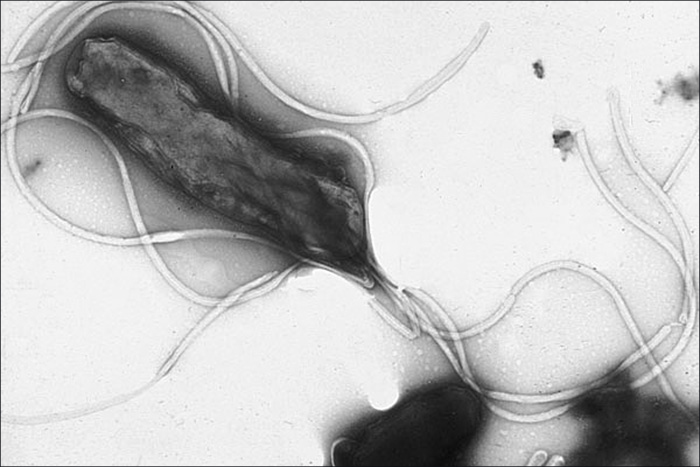| << Chapter < Page | Chapter >> Page > |
The Deltaproteobacteria is a small class of gram-negative Proteobacteria that includes sulfate-reducing bacteria (SRBs), so named because they use sulfate as the final electron acceptor in the electron transport chain. Few SRBs are pathogenic. However, the SRB Desulfovibrio orale is associated with periodontal disease (disease of the gums).
Deltaproteobacteria also includes the genus Bdellovibrio , species of which are parasites of other gram-negative bacteria. Bdellovibrio invades the cells of the host bacterium, positioning itself in the periplasm, the space between the plasma membrane and the cell wall, feeding on the host’s proteins and polysaccharides. The infection is lethal for the host cells.
Another type of Deltaproteobacteria, myxobacteria , lives in the soil, scavenging inorganic compounds. Motile and highly social, they interact with other bacteria within and outside their own group. They can form multicellular, macroscopic “ fruiting bodies ” ( [link] ), structures that are still being studied by biologists and bacterial ecologists. H. Reichenbach. “Myxobacteria, Producers of Novel Bioactive Substances.” Journal of Industrial Microbiology&Biotechnology 27 no. 3 (2001):149–156. These bacteria can also form metabolically inactive myxospores .

[link] summarizes the characteristics of several important genera of Deltaproteobacteria.
| Class Deltaproteobacteria | ||
|---|---|---|
| Genus | Microscopic Morphology | Unique characteristics |
| Bdellovibrio | Gram-negative, comma-shaped rod | Obligate aerobes; motile; parasitic (infecting other bacteria) |
| Desulfovibrio (formerly Desufuromonas ) | Gram-negative, comma-shaped rod | Reduce sulfur; can be used for removal of toxic and radioactive waste |
| Myxobacterium | Gram-negative, coccoid bacteria forming colonies (swarms) | Live in soil; can move by gliding; used as a model organism for studies of intercellular communication (signaling) |
The smallest class of Proteobacteria is Epsilonproteobacteria , which are gram-negative microaerophilic bacteria (meaning they only require small amounts of oxygen in their environment). Two clinically relevant genera of Epsilonproteobacteria are Campylobacter and Helicobacter , both of which include human pathogens. Campylobacter can cause food poisoning that manifests as severe enteritis (inflammation in the small intestine). This condition, caused by the species C. jejuni , is rather common in developed countries, usually because of eating contaminated poultry products. Chickens often harbor C. jejuni in their gastrointestinal tract and feces, and their meat can become contaminated during processing.
Within the genus Helicobacter, the helical, flagellated bacterium H. pylori has been identified as a beneficial member of the stomach microbiota, but it is also the most common cause of chronic gastritis and ulcers of the stomach and duodenum ( [link] ). Studies have also shown that H. pylori is linked to stomach cancer. S. Suerbaum, P. Michetti. “ Helicobacter pylori infection.” New England Journal of Medicine 347 no. 15 (2002):1175–1186. H. pylori is somewhat unusual in its ability to survive in the highly acidic environment of the stomach. It produces urease and other enzymes that modify its environment to make it less acidic.

[link] summarizes the characteristics of the most clinically relevant genera of Epsilonproteobacteria.
| Class Epsilonproteobacteria | ||
|---|---|---|
| Example Genus | Microscopic Morphology | Unique Characteristics |
| Campylobacter | Gram-negative, spiral-shaped rod | Aerobic (microaerophilic); often infects chickens; may infect humans via undercooked meat, causing severe enteritis |
| Helicobacter | Gram-negative, spiral-shaped rod | Aerobic (microaerophilic) bacterium; can damage the inner lining of the stomach, causing chronic gastritis, peptic ulcers, and stomach cancer |
The species ________, which belongs to Epsilonproteobacteria, causes peptic ulcers of the stomach and duodenum.
Helicobacter pylori
The genus Salmonella belongs to the class ________ and includes pathogens that cause salmonellosis and typhoid fever.
Gammaproteobacteria
What is the metabolic difference between coliforms and noncoliforms? Which category contains several species of intestinal pathogens?
Why are Mycoplasma and Chlamydia classified as obligate intracellular pathogens?

Notification Switch
Would you like to follow the 'Microbiology' conversation and receive update notifications?